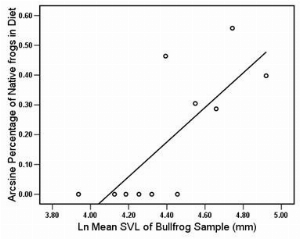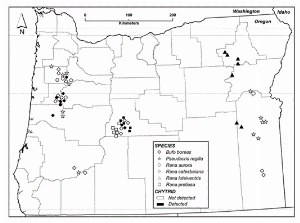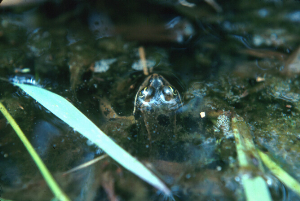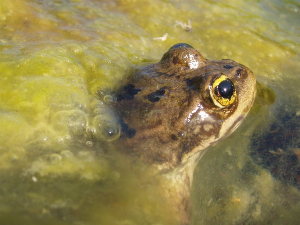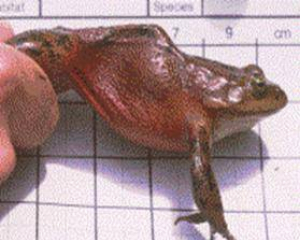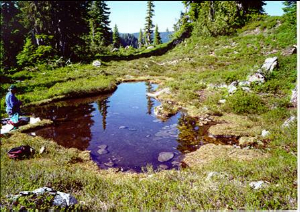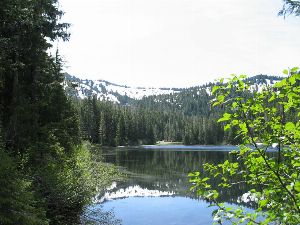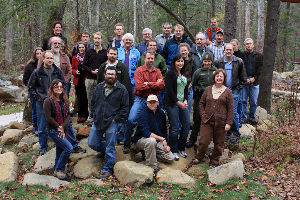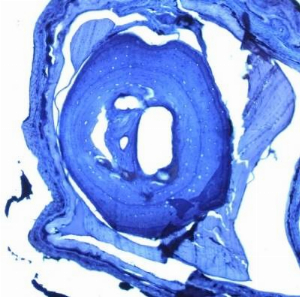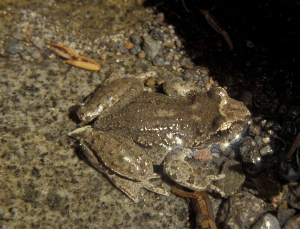Search ARMI Database
Search term(s)
Contribution Number
Search Results
117 record(s) found.
Papers & Reports Using spatiotemporal models and distance sampling to map the space use and abundance of newly metamorphosed western toads (Anaxyrus boreas)
Authors: Nathan D Chelgren; B Samora; Michael J Adams; Brome McCreary
Date: 2011 | Outlet: Herpetological Conservation and Biology 6:175-190
High variability in abundance, cryptic coloration, and small body size of newly metamorphosed anurans have limited demographic studies of this life history stage. We used line-transect distance sampling to estimate the abundance and spatial distribution of newly metamorphosed Western Toads (Anaxyrus boreas) in terrestrial habitat surrounding a montane lake in central Washington, USA. We completed 154 line-transect surveys from the commencement of metamorphosis (15 September, 2009) to the date of first snow accumulation in fall (1 October, 2009), and located 543 newly metamorphosed toads. After accounting for variable detection probability associated with the extent of barren habitats, estimates of total surface abundance ranged from a posterior median of 3880 (95% credible intervals from 2235 to 12600) in the first week of sampling to 12150 (5543, 51670) during the second week of sampling. Numbers of newly metamorphosed toads dropped quickly with increasing distance from the lakeshore in a pattern that differed over the three weeks of the study and contradicted our original hypotheses. Though we hypothesized that the spatial distribution of toads would initially be concentrated near the lake shore and then spread outward from the lake over time, we observed the opposite. Ninety-five percent of individuals occurred within 20, 16, and 15 m of shore during weeks one, two, and three respectively, probably reflecting continued emergence of newly metamorphosed toads from the lake and mortality or burrow use of dispersed individuals. Numbers of toads were highest near the inlet stream of the Lake. Distance sampling may provide a useful method for estimating the surface abundance of newly metamorphosed toads and relating their space use to landscape variables despite uncertain and variable probability of detection.
Papers & Reports Short-term response of Pacific Giant Salamanders to timber management in southwestern Oregon
Authors: N Leuthold; Michael J Adams; J Hayes
Date: 2012-01 | Outlet: Journal of Wildlife Management 76:28-37
In the Pacific Northwest, amphibians inhabit forested streams ranging from barely a trickle up to larger rivers and inhabit streams as well as the surrounding forest. Many previous studies have found a negative effect of timber management on the abundance of stream amphibians, but results have been variable and region specific. These studies have generally used survey methods that do not account for differences in capture probability, which may be important if habitat condition alter capture probabilities. In addition, most of these studies have been retrospective comparisons of stands of different ages, and focus on stands that were harvested under older management practices. Over the last 30 years forest management practices have changed substantially, yet little work examines how modern forest management relates to the abundance or density of stream amphibians. We examined the influences of contemporary forest practices on Pacific giant salamanders as part of the Hinkle Creek paired watershed study. We used a mark-recapture analysis to estimate Pacific giant salamander Density at 100 1-m segments spread throughout the basin and then used extended linear models that accounted for correlation resulting from the repeated surveys at sites across years. Density was associated with substrate, but we found no evidence of an effect of harvest. While holding other factors constant, our top model indicated; 1) each 10 percent increase in proportion of the substrate that was small cobble or larger increased median density of Pacific giant salamanders https://1.06 times, 2) each 100 hectare increase in the area drained decreased median density of Pacific giant salamander https://0.93 times, and 3) increasing the fish density in the 40 m around a site by https://0.01 increased median salamander density https://1.02 times. Our mark-recapture analysis accounted for sampling inefficiencies at sites with captures, but sites with no captures retained densities of 0 in our extended linear analysis. At least some of these sites were likely occupied and we failed to capture individuals that were present. A Monte Carlo analysis suggested that our results were not sensitive to missing captures at some sites. We did not find evidence of a short term effect of timber harvest on the density of Pacific giant salamanders at Hinkle Creek.
Papers & Reports Tailed frog, Ascaphus montanus
Authors: Michael J Adams
Date: 2005 | Outlet: p 382 in Lannoo M (editor). Amphibian declines: the conservation status of United States species. Berkeley: University of California Press
Nielson et al. (2001) recommended that the genus Ascaphus be split into two species: tailed frogs (A. truei) and Montana tailed frogs (A. montanus). Their analysis was based on divergence of mitochondrial DNA and was consistent with previous allozyme work (Daugherty, 1979). The following account highlights references that are specific to the new species. Refer to the Ascaphus truei account for a complete review of the genus Ascaphus.
Papers & Reports Non-native species impacts on pond occupancy by an anuran
Authors: Michael J Adams; Christopher A Pearl; Stephanie K Galvan; Brome McCreary
Date: 2011-01-31 | Outlet: Journal of Wildlife Management 74:30-35
Non?native fish and bullfrogs (Lithobates catesbeianus) are frequently cited as contributing to the decline of ranid frogs in the western United States, so we hypothesized that non?native species, habitat, or a combination of these relate to the probability of local extinction for northern red?legged frogs (Rana aurora) in Oregon, USA. We also hypothesized that the probability of colonization relates to land use, wetland size, or riparian forest. In a 5?yr study, we found no support for an effect of non?native species on northern red?legged frogs. Instead, probability of local extinction decreased with the extent of emergent vegetation and riparian forest. This finding suggests that managers consider the role of habitat when confronting non?native species problems.
Papers & Reports Diet of introduced bullfrogs (Rana catesbeiana): predation on and diet overlap with native frogs on Daishan Island, China
Authors: Z Wu; Y Li; Y Wang; Michael J Adams
Date: 2005-12-01 | Outlet: Journal of Herpetology 39: 668-674
We examined diet of introduced Bullfrogs (Rana catesbeiana) and three native frog species (R. limnocharis, R. nigromaculata and Bufo bufo gargarizans) co-occurring at a group of ponds on Daishan Island, east of China, to gain insight into the nature of potential interactions between Bullfrogs and native frog species. For postmetamorphic Bullfrogs, aquatic prey items dominated volumetrically. Prey size, diet volume and volumetric percentage of native frogs in diet increased with Bullfrog body size. The number and volumetric percentage of native frogs in the diet were not different for female and male Bullfrogs, and both were higher for adults than for juveniles. Diet overlap between males and juveniles was higher than that between males and females and between females and juveniles. Diet overlap with each native frog species of male Bullfrogs was lower than that of female Bullfrogs and juvenile Bullfrogs. We did not exam effects of Bullfrogs on native frogs but our results suggest that the primary threat posed by juvenile Bullfrogs to native frogs on Daishan Island is competition for food while the primary threat posed by male Bullfrogs is direct predation. Female Bullfrogs may threaten native frogs by both competition and predation. These differences among Bullfrog groups may be attributed to differences in body size and microhabitat use.
Papers & Reports Evidence of decline for Bufo boreas and Rana luteiventris in and around the northern Great Basin, western USA.
Authors: W H Wente; Michael J Adams; Christopher A Pearl
Date: 2005 | Outlet: Alytes 23: 95-108
Revisiting historical amphibian sites can provide a relatively fast assessment of amphibian status in a region. Between 2000 and 2003 we repeatedly surveyed historically documented sites for two species of concern in the northern Great Basin: the western toad (Bufo boreas), and the Columbia spotted frog (Rana luteiventris). Both of these species have experienced population declines in other parts of their ranges but their status was relatively unknown in our study area. We estimate that B. boreas occupies 49.5% (34.1% - 65.0%) of 34 historical sites and that R. luteiventris occupies 52.9% (43.5% - 62.3%) of its 30 historical sites. B. boreas was more likely to be detected at human-altered sites while R. luteiventris was more likely to be detected at sites that were deeper than other sites in our study. B. boreas was detected at three of 41 (7.3%) potential sites (located near historic sites) while R. luteiventris was detected at six of 16 (37.5%). At 187 randomly selected sites, B. boreas was detected at one and R. luteiventris at three sites. Given that the number of historical sites available for resurveys was small, these results should be interpreted with caution. Moreover, a species can shift its distribution away from historical sites due to habitat succession or metapopulation dynamics without necessarily declining. We suggest that there is sufficient evidence to conclude that B. boreas and R. luteiventris have declined in and around the northern Great Basin. However, relatively high occupancy of Potential Sites by R. luteiventris suggests they may not have declined as much as B. boreas in the region we surveyed.
Papers & Reports Occurrence of Batrachochytrium dendrobatidis in amphibian populations in Denmark
Authors: R Scalera; Michael J Adams; Stephanie K Galvan
Date: 2008 | Outlet: Herpetological Review 39: 199-200
In summer 2007, we hand captured individual amphibians in Denmark and sampled them for B. dendrobatidis. We found B. dendrobatidis on individuals from both species sampled and at 2 of the 4 study areas we examined. One of the positive results was for an adult of Rana kl. esculenta captured in Vestamager. The other positive result was for a juvenile of Rana temporaria captured in Egense.
Papers & Reports Occurrence of the amphibian pathogen Batrachochytrium dendrobatidis in the Pacific Northwest
Authors: Christopher A Pearl; Evelyn L Bull; David E Green; Jay Bowerman; Michael J Adams; A Hyatt; W H Wente
Date: 2007 | Outlet: Journal of Herpetology 41: 145-149
Chytridiomycosis (infection by the fungus Batrachochytrium dendrobatidis) has been associated with amphibian declines in at least four continents. We report results of disease screens from 210 pond-breeding amphibians from 37 field sites in Oregon and Washington. We detected B. dendrobatidis on 28% of sampled amphibians, and we found >=1 detection of B. dendrobatidis from 43% of sites. Four of seven species tested positive for B. dendrobatidis, including the Northern Red-Legged Frog (Rana aurora), Columbia Spotted Frog (Rana luteiventris), and Oregon Spotted Frog (Rana pretiosa). We also detected B. dendrobatidis in nonnative American Bullfrogs (Rana catesbeiana) from six sites in western and central Oregon. Our study and other recently published findings suggest that B. dendrobatidis has few geographic and host taxa limitations among North American anurans. Further research on virulence, transmissibility, persistence, and interactions with other stressors is needed to assess the potential impact of R. dendrobatidis on Pacific Northwestern amphibians.
Papers & Reports Widespread occurrence of the chytrid fungus Batrachochytrium dendrobatidis on Oregon Spotted Frogs (Rana pretiosa)
Authors: Christopher A Pearl; Jay Bowerman; Michael J Adams; Nathan D Chelgren
Date: 2010 | Outlet: EcoHealth
The pathogen Batrachochytrium dendrobatidis (Bd) has been associated with amphibian declines in multiple continents, including western North America. We investigated Bd prevalence in Oregon spotted frog (Rana pretiosa), a species that has declined across its range in the Pacific Northwest. Polymerase Chain Reaction analysis of skin swabs indicated that Bd was prevalent within populations (420 of 617 juvenile and adults) and widespread among populations (36 of 36 sites) where we sampled R. pretiosa in Oregon and Washington. We rarely detected Bd in R. pretiosa larvae (2 of 72). Prevalence of Bd in post-metamorphic R. pretiosa was inversely related to frog size. We found support for an interactive effect of elevation and sampling date on Bd: prevalence of Bd generally increased with date but this effect was more pronounced at lower elevations. We also found evidence that the body condition of juvenile R. pretiosa with Bd decreased after their first winter. Our data indicate that some Oregon spotted frog populations are currently persisting with relatively high Bd prevalence, but the risk posed by Bd is unknown.
Papers & Reports Characteristics of Columbia spotted frog (Rana luteiventris) oviposition sites in northeastern Oregon
Authors: Christopher A Pearl; Michael J Adams; W H Wente
Date: 2007-01 | Outlet: Western North American Naturalist 67: 86-91
Several western ranid frogs possess a unique strategy of breeding communally over a short temporal window and reusing oviposition sites between years. However, little is published on the characteristics of oviposition sites selected by these explosive breeders. The Columbia spotted frog (Rana luteiventris) is native to northwestern North America and is of conservation concern in the southern portions of its range. As part of a study examining relationships between livestock grazing and R. luteiventris habitat, we assessed characteristics of the species’ oviposition sites in 25 fishless ponds in northeastern Oregon. Oviposition sites were generally in shallow water (25 cm) close to shore and tended to be in the northeastern portion of ponds. Oviposition sites were found more frequently over heavily vegetated substrates and in areas of less substrate slope and shade than random points in littoral zones. We did not quantify temperature differences within ponds but the patterns we documented are consistent with preferential use of warmer microhabitats for oviposition.
Papers & Reports Behavioral responses of anuran larvae to chemical cues of native and introduced predators in the Pacific Northwestern United States
Authors: Christopher A Pearl; Michael J Adams; G S Schuytema; A V Nebeker
Date: 2003-09-01 | Outlet: Journal of Herpetology 37: 572-576
We compared behavioral responses of three Pacific Northwest anuran larvae from different hydroperiods to water born cues of native and introduced predators. Two native anurans (Pacific treefrog, Pseudacris regilla and northern red-legged frog, Rana aurora aurora) and introduced bullfrogs (Rana catesbeiana) responded to water conditioned by native redside shiners (Richardsonius balteatus) by increasing refuge use. The two native anuran larvae differed in their response to introduced predator cues. Rana a. aurora, which occur in temporary and permanent waters, responded to both introduced bluegill sunfish (Lepomis macrochirus) and introduced crayfish (Procambarus clarkii). Pseudacris regilla, which occur primarily in temporary ponds, did not respond to water born cues from either introduced predator. The broader responses of R. a. aurora may indicate greater behavioral plasticity or more exposure to novel predators than experienced by P. regilla. Larvae of introduced R. catesbeiana responded strongly to cues from two fish native to the Pacific northwest, but did not alter behavior in response to any of five potential predators with which they co-occur in their native range. Fish that occur with R. catesbeiana in their native range generally find bullfrog tadpoles unpalatable. This pattern suggests that bullfrog larvae can recognize cues of novel predators that may find them palatable, which could contribute to their success as an invasive species in the region.
Papers & Reports Breeding habitat and local population size of the Oregon spotted frog (Rana pretiosa) in Oregon, USA
Authors: Christopher A Pearl; Michael J Adams; N Leuthold
Date: 2010 | Outlet: Northwestern Naturalist 91
The distribution of the Oregon Spotted Frog (Rana pretiosa) has shrunk markedly and more than 2/3 of known populations are located along the Cascade Range in central Oregon. Despite the conservation concern, little is known about how habitat attributes and stressors such as invasive species influence R. pretiosa populations. We used egg mass counts to study R. pretiosa habitat relationships at oviposition sites and breeding ponds. Oviposition sites were in shallow water above gradually sloping substrates that supported moderate or dense herbaceous vegetation. Sixty-one per cent of occupied breeding ponds had fewer than 20 egg masses. We found strong support for two predictors of egg mass count: positive effect of other R. pretiosa breeding sites nearby and a negative effect of non-native fish having access to preferred R. pretiosa overwintering habitat. We found moderate support for effects of emergent and submergent vegetation coverage (positive) and of ponds being located in the Klamath Basin (negative). Maintaining and restoring overwintering habitats that are free of non-native game fish is likely to benefit R. pretiosa. Further work on movement ecology is needed to improve our understanding of habitat connectivity and the effects of site isolation on the persistence of R. pretiosa in Oregon.
Papers & Reports Asymmetrical effects of non-native bullfrogs (Rana catesbeiana) on native ranid frogs in Oregon, USA
Authors: Christopher A Pearl; Michael J Adams; Richard B Bury; Brome McCreary
Date: 2004-02-01 | Outlet: Copeia 2004: 11-20
Introduced American bullfrogs (Rana catesbeiana) have become widely established in the Pacific Northwest over the last century, and are thought to be an important predator of native amphibians throughout the western USA. The northern red-legged frog (Rana aurora aurora) and Oregon spotted frog (Rana pretiosa) historically co-occurred in portions of the Pacific Northwest now invaded by R. catesbeiana, but R. pretiosa has declined more severely than R. a. aurora. We investigated whether microhabitat and behavioral differences that facilitate sympatric coexistence of the natives predict which species is more susceptible to predation by introduced R. catesbeiana. Our laboratory experiments demonstrate that R. catesbeiana adults prefer aquatic microhabitats, R. pretiosa juveniles are more aquatic than R. a. aurora, and that adult R. catesbeiana consume more R. pretiosa than R. a. aurora juveniles. Mean and maximum jump distances of R. pretiosa were shorter than equally-sized R. a. aurora, and the difference between these two species increased with larger frog sizes. Our examination of field survey data indicates that R. pretiosa co-occur with R. catesbeiana less frequently than R. a. aurora. We conclude that R. catesbeiana is a greater threat to survival of R. pretiosa than to R. a. aurora, and suggest that microhabitat use and escape abilities of native ranid frogs may be linked to this asymmetrical effect. Analysis of behavioral and microhabitat differences among related native species may be a useful tool in predicting the effects of introduced predators on amphibians, and can assist in developing conservation priorities for these species.
Papers & Reports Amphibian occurrence and aquatic invaders in a changing landscape: implications for wetland mitigation in the Willamette Valley, Oregon
Authors: Christopher A Pearl; Michael J Adams; Richard B Bury; N Leuthold
Date: 2005-03-01 | Outlet: Wetlands 25: 76-88
Despite concern about the conservation status of amphibians in western North America, few field studies have documented occurrence patterns of amphibians relative to potential stressors. We surveyed wetland fauna in Oregon’s Willamette Valley and used an information theoretic approach (AIC) to rank the associations between native amphibian breeding occurrence and wetland characteristics, non-native aquatic predators, and landscape characteristics in a mixed urban-agricultural landscape. Best predictors varied among the 5 native amphibians, and were generally consistent with life history differences. Pacific tree frog (Pseudacris regilla) and long-toed salamander (Ambystoma macrodactylum) occurrence was best predicted by the absence of non-native fish. Northern red-legged frog (Rana aurora) and northwestern salamander (Ambystoma gracile) were most strongly related to wetland vegetative characteristics. The occurrence of rough-skinned newts (Taricha granulosa), a migratory species that makes extensive use of terrestrial habitats, was best predicted by greater forest cover within 1 km. The absence of non-native fish was a strong predictor of occurrence for 4 of the 5 native species. In contrast, amphibians were not strongly related to native fish presence. We found little evidence supporting negative effects of the presence of breeding populations of bullfrog (Rana catesbeiana) on any native species. Only the 2 Ambystoma salamanders were associated with wetland permanence. Northwestern salamanders (which usually have a multi-year larval stage) were associated with permanent waters, while long-toed salamanders were associated with temporary wetlands. Although all the species make some use of upland habitats, only one (rough-skinned newt) was strongly associated with surrounding landscape conditions. Instead, our analysis suggests within wetland characteristics best predict amphibian occurrence in this region. We recommend that wetland preservation and mitigation efforts concentrate on sites lacking non-native fish for the conservation of native amphibians in the Willamette Valley and other western lowlands.
Papers & Reports Rana cascadae Slater, 1939, Cascade Frog
Authors: Christopher A Pearl; Michael J Adams
Date: 2005 | Outlet: Lannoo M, editor. Amphibian declines: the conservation status of United States species. Berkeley: University of California Press Pp 538-540
A species account for Rana cascadae.
Papers & Reports Optical characteristics of natural waters protect amphibians from UV-B in the US Pacific Northwest: reply
Authors: Wendy J Palen; D E Schindler; Michael J Adams; Christopher A Pearl; Richard B Bury; S Diamond
Date: 2004-06-01 | Outlet: Ecology 85: 1754-1759
Few ecologists would dispute that exposure to high levels of ultraviolet-B radiation (UV-B) is detrimental to organisms. It is well established that UV-B has been a critical factor shaping the physiology (Blum et al. 1949, Hansson 2000), behavior (Pennington and Emlet 1986, van de Mortel and Buttemer 1998), and distribution (Williamson et al. 2001, Leavitt et al. 2003) of many aquatic species. Recently, increasing UV-B caused by stratospheric ozone depletion has stimulated much research on the UV-B sensitivity of a wide variety of taxa, and has been found to cause direct mortality (Calkins and Thordardottir 1980, reviewed by Siebeck et al. 1994), elevate developmental abnormalities (Ankley et al. 2002), increase susceptibility to disease (Little and Fabacher 1994, Kiesecker and Blaustein 1995), and change the strength of species interactions (Sommaruga 2003). Increasing levels of UV-B have also been invoked as an explanation for the decline of some amphibian species, and support for this hypothesis has been extrapolated from many laboratory experiments and field studies at individual sites that indicate ambient or enhanced levels of UV-B can increase mortality of embryos and larvae (but see Licht 2003). This has been an especially attractive hypothesis for amphibian populations in alpine environments where direct anthropogenic impacts such as habitat modification are limited and ambient levels of UV-B are high (Blaustein and Wake 1990, Blaustein et al. 1994, Alford and Richards 1999). However, for all the attention UV-B has received in the context of declining amphibian populations, there is little evidence linking the physiological sensitivity of individuals to actual population dynamics (Licht 2003).
Papers & Reports Optical characteristics of natural waters can protect amphibian populations from UV-B in the US Pacific Northwest
Authors: Wendy J Palen; D E Schindler; Michael J Adams; Christopher A Pearl; Richard B Bury; S Diamond
Date: 2002 | Outlet: Ecology 83: 2951-2957
Increased exposure to ultraviolet-B (UV-B) radiation has been proposed as a major environmental stressor leading to global amphibian declines. Prior experimental evidence from the US Pacific Northwest (PNW) has established the embryonic sensitivity of at least 4 amphibian species to UV-B and has been central to the amphibian decline literature. However, these results have not been expanded to address population-scale effects and natural landscape variation in UV-B transparency of water at amphibian breeding sites; necessary links to assess the importance of UV-B for amphibian declines. We quantified the UV-B transparency of 136 potential amphibian breeding sites to establish the pattern of UV-B exposure across two montane regions in the PNW. Our data suggest that 85% of sites are naturally protected by dissolved organic matter (DOM) in pond water, and that only a fraction of breeding sites are likely to experience UV-B intensities exceeding levels associated with elevated egg mortality. Thus, the spectral characteristics of natural waters mediate the physiological effects of UV-B on amphibian eggs in all but the clearest sites. These data imply that UV-B is unlikely to cause broad amphibian declines across the landscape of the American Northwest.
Papers & Reports The U.S. Department of Interior’s Amphibian Research and Monitoring Initiative: a successful start to a national program
Authors: Erin Muths; R E Jung; Larissa L Bailey; Michael J Adams; P. Stephen Corn; Kenneth C Dodd; Gary M Fellers; Walt J Sadinski; Cecil R Schwalbe; Susan C Walls; Robert N Fisher; A L Gallant; William A Battaglin; David E Green
Date: 2005 | Outlet: Applied Herpetology 2: 355–371
Most research to assess amphibian declines has focused on local-scale projects on one or a few species. The Amphibian Research and Monitoring Initiative (ARMI) is a national program in the United States mandated by congressional directive and implemented by the U.S. Department of the Interior (specifically the U.S. Geological Survey, USGS). Program goals are to monitor changes in populations of amphibians across U.S. Department of the Interior lands and to address research questions related to amphibian declines using a hierarchical framework of base-, mid- and apex-level monitoring sites. ARMI is currently monitoring 83 amphibian species (29% of species in the U.S.) at mid- and apex-level areas. We chart the progress of this 5-year-old program and provide an example of mid-level monitoring from 1 of the 7 ARMI regions.
Papers & Reports A Protocol for Aging Anurans Using Skeletochronology
Authors: Brome McCreary; Christopher A Pearl; Michael J Adams
Date: 2008 | Outlet: US Geological Survey Open-File Report 2008-1209
Age distribution information can be an important part of understanding the biology of any population. Age estimates collected from the annual growth rings found in tooth and bone cross sections, often referred to as Lines of Arrested Growth (LAGs), have been used in the study of various animals. In this manual we describe in detail all necessary steps required to obtain estimates of age from anuran bone cross sections via skeletochronological assessment. We include comprehensive descriptions of how to fix and decalcify toe specimens (phalanges), process a phalange prior to embedding, embed the phalange in paraffin, section the phalange using a microtome, stain and mount the cross sections of the phalange and read the LAGs to obtain age estimates.
Papers & Reports Taxonomic variation in oviposition by tailed frogs (Ascaphus spp.)
Authors: N E Karraker; David S Pilliod; Michael J Adams; Evelyn L Bull; P. Stephen Corn; L V Diller; L A Dupuis; Marc P Hayes; Blake R Hossack; G R Hodgson; E J Hyde; K Lohman; B R Norman; Lisa M Ollivier; Christopher A Pearl
Date: 2006 | Outlet: Northwestern Naturalist 87: 87-97
Tailed frogs (Ascaphus spp.) oviposit in cryptic locations in streams of the Pacific Northwest and Rocky Mountains. This aspect of their life history has restricted our understanding of their reproductive ecology. The recent split of A. montanus in the Rocky Mountains from A. truei was based on molecular differentiation, and comparisons of their ecology are limited. Our objectives were to provide a range-wide summary of information on Ascaphus oviposition,compare some aspects of the reproductive ecology of the 2 species, and examine geographic variation in their reproductive traits. Reproductive ecology of the 2 species differed. Ascaphus truei had smaller clutches, oviposited later in the summer, and had a longer duration of oviposition than A. montanus. A greater number of communal oviposition sites were attributed to A. montanus. These ecological differences support the recent taxonomic revision of Ascaphus and suggest that different management strategies may be necessary for each species where conservation is a priority.

